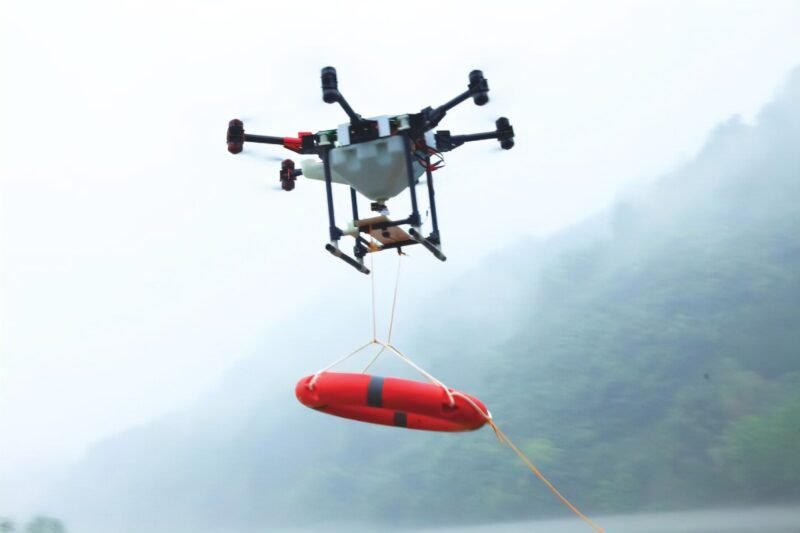When disaster strikes, every second counts. In recent years, drones (UAVs) have emerged as indispensable tools for emergency response teams worldwide. From search missions in rugged terrain to restoring communication in crisis zones, these high-tech devices are rewriting the rules of disaster management. Let’s explore five groundbreaking ways drones save lives during emergencies.
1. Aerial Search & Rescue: Eyes in the Sky, Day or Night
Equipped with thermal imaging cameras, night vision, and AI-powered zoom, modern drones act as aerial scouts that outperform human limitations. They swiftly cover vast areas, penetrating dense forests, collapsed buildings, or floodwaters while transmitting real-time footage to command centers.
- Thermal Detection: Infrared sensors detect body heat signatures, pinpointing survivors trapped under rubble or lost in wilderness—even in total darkness.
- Panoramic Mapping: Drones like DJI Matrice 300 RTK capture 360° overviews, geotagging critical data for rapid decision-making.
- Speed Advantage: As shared by Luo Xiao, a rescue expert from Gansu UAV Emergency Service, “Drones reach remote disaster sites in minutes, while ground teams might need hours.”
Pro Tip: Even consumer drones have made headlines—hobbyists using DJI Mavic models have accidentally located drowning victims during routine flights!
2. Emergency 3D Mapping: Rebuilding the Bigger Picture
After earthquakes or landslides, drone-based photogrammetry rebuilds disaster zones digitally. Using oblique cameras or LiDAR, UAVs create centimeter-accurate 3D models that reveal hidden risks and guide rescue strategies.
- Case Study: During the 2015 Nepal earthquake, DJI Phantom 3 drones mapped villages in ruins, accelerating reconstruction planning.
- Innovation in Action: In 2021, during Zhengzhou’s subway flooding, a drone flew 500 meters into a pitch-dark tunnel, generating instant 3D maps for rescue crews.
This technology not only aids immediate operations but also supports long-term risk assessment and infrastructure recovery.
3. Airborne Delivery: Lifelines from the Sky
When roads are impassable, drones become flying supply trucks. Industrial UAVs like DJI Agras MG-1P (designed for crop spraying) have been repurposed to airlift essentials:
- Medical Emergencies: In Indonesia’s COVID-19 Delta wave, volunteers delivered medicines via drones to isolated patients.
- Flood Rescue: In 2018, three agricultural drones air-dropped 2 truckloads of supplies to 143 workers stranded on a Sichuan island, bypassing raging floodwaters.
With payloads up to 20kg, next-gen drones could soon transport defibrillators, blood samples, or even rescue ropes.
4. Flying Cell Towers: Restoring Communication
Broken infrastructure often leaves disaster zones in a communication blackout. Enter drone-mounted mobile base stations:
- Life-Saving Signal: During China’s 2021 Henan floods, the Wing Loong-2H UAV flew 1,200km to beam 50km² of 4G coverage, reconnecting thousands via SMS.
- Cost-Effective Alternative: Compared to satellite phones, temporary drone networks offer wider reach at lower costs.
5. Night Rescue Illumination: Lighting Up the Darkness
Tethered drones like Hytera SkyFlight serve as aerial floodlights, hovering for hours to illuminate rescue sites. Combined with thermal imaging, they turn night into day for operations—whether extracting avalanche survivors or repairing power lines.
Why Drones Are the Future of Emergency Response
- Speed: Deploy 10x faster than ground teams.
- Safety: Keep responders out of hazardous zones.
- Cost Efficiency: Slash operational expenses by 30-50% (UN Disaster Risk Reduction Report).
From the Himalayas to hurricane-hit coasts, drones are proving their worth. As AI and battery tech evolve, expect even smarter swarms of rescue UAVs—detecting SOS signals autonomously or navigating complex urban rubble.
Final Thought: Next time disaster strikes, look up. The whir of rotors might just signal hope arriving from above.

